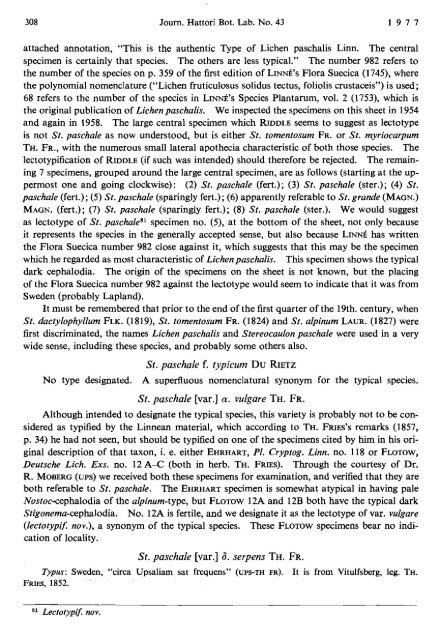A CONSPECTUS OF THE LICHEN GENUS STEREOCAULON ...
A CONSPECTUS OF THE LICHEN GENUS STEREOCAULON ...
A CONSPECTUS OF THE LICHEN GENUS STEREOCAULON ...
Create successful ePaper yourself
Turn your PDF publications into a flip-book with our unique Google optimized e-Paper software.
308 Joum. Hattori Bot. Lab. No. 43 1977<br />
attached annotation, "This is the authentic Type of Lichen paschalis Linn. The central<br />
specimen is certainly that species. The others are less typical." The number 982 refers to<br />
the number of the species on p. 359 of the first edition of LINNJYS Flora Suecica (1745), where<br />
the polynomial nomenclature ("Lichen fruticulosus solidus tectus, foliolis crustaceis") is used;<br />
68 refers to the number of the species in LINNE'S Species Plantarum, vol. 2 (1753), which is<br />
the original publication of Lichenpaschalis. We inspected the specimens on this sheet in 1954<br />
and again in 1958. The large central specimen which RIDDLE seems to suggest as lectotype<br />
is not St. paschale as now understood, but is either St. tomentosum FR. or St. myriocarpum<br />
TH. FR., with the numerous small lateral apothecia characteristic of both those species. The<br />
lectotypification of RIDDLE (if such was intended) should therefore be rejected. The remaining<br />
7 specimens, grouped around the large central specimen, are as follows (starting at the uppermost<br />
one and going clockwise): (2) St. paschale (fert.); (3) St. paschale (ster.); (4) St.<br />
paschale (fert.); (5) St. paschale (sparingly fert.); (6) apparently referable to St. grande (MAGN.)<br />
MAGN. (fert.); (7) St. paschale (sparingly fert.); (8) St. paschale (ster.). We would suggest<br />
as lectotype of St. paschales' specimen no. (5), at the bottom of the sheet, not only because<br />
it represents the species in the generally accepted sense, but also because LINN~ has written<br />
the Flora Suecica number 982 close against it, which suggests that this may be the specimen<br />
which he regarded as most characteristic of Lichenpaschalis. This specimen shows the typical<br />
dark cephalodia. The origin of the specimens on the sheet is not known, but the placing<br />
of the Flora Suecica number 982 against the lectotype would seem to indicate that it was from<br />
Sweden (probably Lapland).<br />
It must be remembered that prior to the end of the first quarter of the 19th. century, when<br />
St. dactylophyllum FLK. (1819), St. tomentosum FR. (1824) and St. alpinum LAUR. (1827) were<br />
first discriminated, the names Lichen paschalis and Stereocaulon paschale were used in a very<br />
wide sense, including these species, and probably some others also.<br />
St. paschale f. typicum DU RIETZ<br />
No type designated. A superfluous nomenclatural synonym for the typical species.<br />
St. paschale [var.] a. vulgare TH. FR.<br />
Although intended to designate the typical species, this variety is probably not to be considered<br />
as typified by the Linnean material, which according to TH. FRIES'S remarks (1857,<br />
p. 34) he had not seen, but should be typified on one of the specimens cited by him in his original<br />
description of that taxon, i. e. either EHRHART, PI. Cryptog. Linn. no. 118 or FLOTOW,<br />
Deutsche Lich. Ens. no. 12 A-C (both in herb. TH. FRIES). Through the courtesy of Dr.<br />
R. MOBERG (UPS) we received both these specimens for examination, and verified that they are<br />
both referable to St. paschale. The EHRHART specimen is somewhat atypical in having pale<br />
Nostoc-cephalodia of the alpinum-type, but FLOTOW 12A and 12B both have the typical dark<br />
Stigonema-cephalodia. No. 12A is fertile, and we designate it as the lectotype of var. vulgare<br />
(lectotypif. nov.), a synonym of the typical species. These FLOTOW specimens bear no indication<br />
of locality.<br />
St. paschale [var.] 6. serpens TH. FR.<br />
Typus: Sweden, "circa Upsaliam sat frequens" (UPS-TH FR). It is from Vitulfsberg, leg. TH.<br />
FRIES, 1852.<br />
Lectotypif. nov.

















